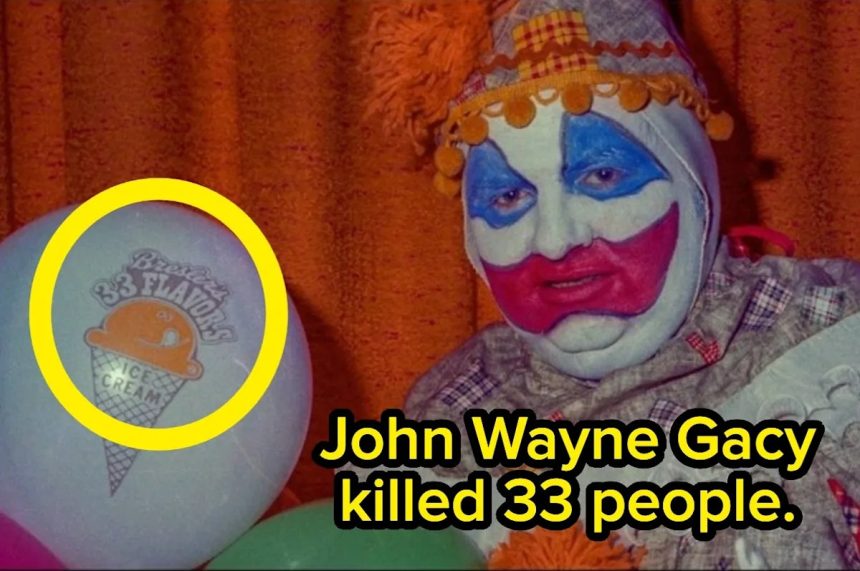Do you love all things terrifying, dark, and creepy? Subscribe to the That Got Dark newsletter to get your weekly dopamine fix of the macabre delivered RIGHT to your inbox!
BuzzFeed
Warning: Graphic content ahead, including stories of murder and suicide.
1. In a very creepy and ironic twist, I recently found out that infamous serial killer John Wayne Gacy*, who was convicted of 33 murders, had also been a contractor for Bresler’s 33 Flavors, an ice cream chain in the Chicago area during the ’70s. There’s even a chilling photo of him from a documentary on Peacock, John Wayne Gacy: Devil in Disguise, showing him as “Pogo the Clown” holding a “33 Flavors” balloon from Bresler’s.

Peacock, Marty Zielinski / Peacock
*Known as the Killer Clown — a moniker given because of his public appearances as a clown before the discovery of his crimes — Gacy was a serial killer active in the Chicago area in the 1970s, with at least 33 victims. He would rape and torture his victims — young men and boys — before killing them either by asphyxiation or strangulation. Gacy was executed by lethal injection in May 1994.
The photo was taken by his photographer friend Marty Zielinski, who is also in the documentary.

Marty Zielinski / Peacock
And it seems Gacy was well aware of this ironic connection. In one of his last interviews, Gacy said, “I used to do clowning — I don’t know if you want to mention the name — for an ice cream company in Chicago, who had 33 flavors. I used to [laughs], I’m serious. [It was] a restoration company, I was their contractor, and I was also their clown.”

World History Archive / Alamy
2. In a haunting twist of fate, teenagers Stephanie Hart-Grizzell and Nick Kunselman — both survivors of the Columbine High School shooting — were murdered just a year later on Feb. 14, 2000, inside a Subway shop near their school.

Nick, who worked at the Subway, was found shot behind the counter, while Stephanie was discovered nearby. The two were reportedly dating, and Stephanie had apparently gone there that night to meet him after his shift, which is when both were killed.

Witnesses reported seeing a white male leaving the area, but despite interviews, tips, and an ongoing investigation, no arrests have ever been made. More than two decades later, the murders remain unsolved.

3. On Sept. 14, staff at a Brooklyn nursing home found 95-year-old Galina Smirnova washing blood off her hands after she allegedly killed her 89-year-old roommate, Nina Kravtsov, a Holocaust survivor who was discovered fatally injured in her bed.

The medical examiner determined Kravtsov had died from blunt force trauma, and investigators identified a bloodstained wheelchair foot pedal as the suspected weapon.

Three days later, on Sept. 17, Smirnova was arraigned and charged with second-degree murder and weapon possession. She was remanded without bail and did not enter a plea. No clear motive has been publicly reported.
4. Just weeks ago, a man named Yordanis Cobos-Martinez allegedly killed and decapitated his coworker and motel manager, Chandra “Bob” Nagamallaiah, at a motel in Dallas.

Witnesses, including Nagamallaiah’s wife and son, saw the attack, which reportedly began after a dispute over a broken washing machine. According to police, Cobos-Martinez returned with a machete, chased Nagamallaiah through the motel, and fatally beheaded him before disposing of the head in a dumpster.

Cobos-Martinez was later found covered in blood, still holding the machete, and arrested. He admitted to the killing in a recorded statement and is being held in Dallas County Jail on a capital murder charge.

5. On April 13, 1977, the remains of a man — later nicknamed “Septic Tank Sam” — were discovered burned and dumped in a septic tank on a rural farm near Tofield, Alberta.

The victim had been tortured, burned, sexually mutilated, and shot before his body was placed headfirst into the tank. For decades, investigators tried to identify him through dental records, reconstructions, and missing persons reports, but without success.

Jena Ardell / Getty Images
In 2021, advances in genetic genealogy finally provided a breakthrough: DNA from the remains was used to build a family tree that led police to relatives in Canada and the United States, confirming the victim as Gordon Edwin Sanderson of Edmonton. The homicide remains unsolved.

Cavan Images / Getty Images
6. On Sept. 24, a massive sinkhole opened on Samsen Road in Bangkok, collapsing a four-lane street, toppling electricity poles, damaging water pipes, and swallowing several vehicles. The incident forced evacuations of nearby buildings, including a police station and a hospital. Officials linked the collapse to ongoing subway construction, with a burst water pipe and heavy monsoon rains possibly worsening the failure. Thankfully, no deaths or injuries were reported.

Related: 15 Shocking Stories So Unhinged We Almost Didn’t Hit Publish
7. On Sept. 30, 1999, a man named Hisashi Ouchi was exposed to lethal radiation during a criticality accident at a fuel-processing plant in Tokaimura, Japan.

Sot / Getty Images
Workers had bypassed safety procedures and manually poured enriched uranium, triggering an uncontrolled chain reaction that delivered Ouchi the highest known radiation dose ever recorded in a human. He suffered catastrophic burns, organ damage, and the near destruction of his immune system.

– / JIJI PRESS/AFP via Getty Images
Despite 83 days of intensive treatment, including stem cell transplants and life support, he died on Dec. 21, 1999, from multiple organ failure.
8. The tragedy of the Lake Nyos disaster, a rare and devastating eruption that happened in northwestern Cameroon in 1986. The tragic event triggered the sudden release of about 100,000–300,000 tons of carbon dioxide, killing nearly 2,000 people and roughly 3,500 livestock.

Eric BOUVET / Gamma-Rapho via Getty Images
It’s believed that most of the victims had been poisoned by a mixture of gases. In addition to eye and nose pain, victims also suffered asphyxiation, similar to being strangled.

Eric BOUVET / Gamma-Rapho via Getty Images
9. The mystery of two brothers named Willie and Frank McLeod, who, in 1908, were found dead near the South Nahanni River in Canada’s Northwest Territories, both missing their heads.

Toronto Star Archives / Toronto Star via Getty Images
Over the following decades, more prospectors were discovered under similar circumstances, including Martin Jorgensen in 1917 and John O’Brien in 1945. These cases eventually gave rise to the region’s ominous nickname, “The Valley of Headless Men.”

DEA / BIBLIOTECA AMBROSIANA / De Agostini via Getty Images
Despite theories ranging from rival prospectors to Indigenous defense of territory, animal scavenging, or even supernatural causes, the deaths were never explained and remain unsolved.

Duncan1890 / Getty Images
10. In the spring of 1922, six people living and working on the Hinterkaifeck farm, located in rural Germany, were killed by an unknown assailant, in what would become known as the Hinterkaifeck murders, one of Germany’s most infamous unsolved crimes.

FM Archive / Alamy
The six victims ranged from age 2 to 72. Four of the victims’ bodies were discovered in the barn, battered and covered with hay, while the other two were found inside the house, also covered.

Sueddeutsche Zeitung Photo / Alamy
Apparently, the killer(s) remained on the farm for a few days and even took care of and fed the farm animals. Although there have been some theories over the last hundred years as to what happened, the gruesome case still remains unsolved.
11. The tragic and heartbreaking story of Rosemary Kennedy, John F. Kennedy’s sister, who was often referred to as the Kennedys’ “Dark Secret.”

Bettmann / Bettmann Archive
During Rosemary’s birth, the attending doctor was delayed, and a nurse instructed her mother, Rose, to keep her legs closed to postpone the delivery. For two hours, this restriction deprived baby Rosemary of oxygen, which is believed to have caused a brain injury that resulted in lifelong developmental disabilities.

Bettmann / Bettmann Archive
As Rosemary grew older, her behavioral struggles and mood swings increasingly alarmed her family, who were extremely conscious of their public image. In 1941, at age 23, her father arranged a secret lobotomy — without telling her mother — that involved drilling holes into both sides of her head and inserting a medical spatula into her cranium. The procedure was reportedly botched, and it left Rosemary with the mental capacity of a toddler. She spent the rest of her life in institutions, hidden from public view.

Bachrach / Getty Images
For decades, little was known about Rosemary, while the rest of the Kennedys projected an image of glamour, intelligence, and success. However, in the 1960s, her story began to surface through journalists and biographers. The secrecy surrounding her contrasted sharply with the family’s polished image, and she was often described as their “dark secret.” Eventually, Rosemary’s siblings acknowledged her more openly and shifted their narrative toward disability advocacy, particularly through the Special Olympics.

Bettmann / Bettmann Archive
12. The story of the Hexham Heads, two crude little stone carvings were dug up by some kids in a garden in Hexham, England in 1971.

Capital Pictures /Alamy
Almost immediately, the family who found them was plagued by eerie disturbances — unexplained noises, poltergeist-like activity, and even sightings of a menacing, werewolf-like figure lurking around.

Motortion / Getty Images/iStockphoto
Unsurprisingly, the heads gained a reputation in paranormal circles, and they were even studied by archaeologists. Some researchers believe they were of Celtic origin, while others think they may have been made in more modern times. After being passed through private collectors and researchers for many years, the heads eventually became lost, and their current whereabouts are unknown.

13. The existence of cow portholes, surgically installed plastic or rubber hatches placed into the side of a living cow’s stomach, which allow researchers and farmers to open the port and reach directly into part of the cow’s stomach.

JEAN-FRANCOIS MONIER / AFP via Getty Images
The procedure is used to study digestion, test feed efficiency, and even transfer microbes from a healthy cow to a sick one. Though cows can live normally after the surgery, the sight of someone pulling handfuls of fermenting grass through a “window” in a cow’s side is both bizarre and unsettling.

JEAN-FRANCOIS MONIER / AFP via Getty Images
14. In May 2011, a man named Kim Jun-bong was found crucified in an abandoned quarry in Mungyeong, South Korea. He was nailed to a wooden cross with a crown of thorns, flanked by two smaller crosses, and bearing a stab wound in his side.

Klee / Getty Images/iStockphoto
Investigators found nearby tools (including drills), a handwritten memo with instructions on self-crucifixion, and symbolic details matching the biblical narrative — inscriptions, mirrors, and a rope around his neck.

Forensic analysis by the National Forensic Service concluded that Kim died from a combination of heavy bleeding and suffocation and determined it was physically possible he carried out the crucifixion on his own. Not long after, police officially closed the case, ruling it a suicide with no evidence of outside assistance.
15. The horrifying story of serial killer Jack Harrison Trawick, often called the “Birmingham Killer” in the media, who was convicted of two murders and suspected of several more in Alabama.

ImagesbyTrista / Getty Images
In 1992, Trawick killed Aileen Pruitt and Stephanie Gach, receiving a life sentence for the first crime and the death penalty for the second. Diagnosed with paranoid schizophrenia, he later claimed responsibility for other killings, though most were never verified. Trawick even reportedly taunted his victims’ families from prison by describing details of the murders and showing no remorse in letters and drawings that were posted to the internet. After years of appeals, Trawick was executed by lethal injection in 2009.

SCM Jeans / Getty Images
16. The unintentional, self-documented death of Karl Patterson Schmidt, a respected herpetologist who was bitten in 1957 by a boomslang snake he was examining.

At first, he thought the bite wouldn’t be serious, so he skipped medical treatment and instead took notes on how his body reacted. But the venom was devastating — it triggered unstoppable internal bleeding, making him vomit blood and bleed from his eyes, nose, and internal organs. By the next day, he collapsed at home, was rushed to the hospital, and was pronounced dead shortly after.

17. The upsetting story of Kenneth McDuff, a serial killer from Texas, who was caught and sentenced to death, then released on parole, and then recaptured after committing more murders.

In 1966, McDuff committed the “Broomstick Murders,” killing three teenagers, including one girl who was strangled with a broomstick — giving the case its name. He was sentenced to death, later reduced to life in prison, but paroled in 1989 despite warnings. After his release, he abducted and killed a young woman, and is suspected of other murders around that time, before being captured again in 1992. He was executed by lethal injection in 1998.

18. In 1783, a boy known as the “Two-Headed Boy of Bengal” was born with a rare condition called craniopagus parasiticus, meaning a second, undeveloped head was attached upside down to the top of his skull. Allegedly, the extra head could blink, suck, and even appear to smile, though it had no independent body.

Science History Images / Alamy
Historical medical reports confirm the physical anomaly, but claims that the second head was fully functional or that the boy heard it “speaking” to him are considered sensationalized and not supported by more modern scientific reviews. The child lived only a few years before dying from a cobra bite, and his skull was preserved for study in medical collections.

The History Collection / Alamy
19. Finally, this TikTok video of eyeliner tattoo removal that, FAIR WARNING, is NOT what you’d expect and will probably leave you screaming…

SWEET DREAMS!!!!
Love this kind of content? Subscribe to the That Got Dark newsletter to get more like it delivered RIGHT to your inbox!

BuzzFeed
Dial 988 in the United States to reach the National Suicide Prevention Lifeline. The 988 Lifeline is available 24/7/365. Your conversations are free and confidential. Other international suicide helplines can be found at befrienders.org. The Trevor Project, which provides help and suicide-prevention resources for LGBTQ youth, is 1-866-488-7386.
Also in BuzzFeed: Most Americans Are So Bad At Geography, I Bet They Couldn’t Pass This Middle School Quiz
Also in BuzzFeed: Your Brain Works In One Of Three Ways — Thinker, Solver, Or Doer — And This Quiz Will Reveal Which One
Also in BuzzFeed: 17 Very, Very, Very, Very, Very, Very Dark And Tragic Things I Just Learned About That Melted My Brain
- Do you love all things terrifying, dark, and creepy? Subscribe to the That Got Dark newsletter to get your weekly dopamine fix of the macabre delivered RIGHT to your inbox!
- 1. In a very creepy and ironic twist, I recently found out that infamous serial killer John Wayne Gacy*, who was convicted of 33 murders, had also been a contractor for Bresler’s 33 Flavors, an ice cream chain in the Chicago area during the ’70s. There’s even a chilling photo of him from a documentary on Peacock, John Wayne Gacy: Devil in Disguise, showing him as “Pogo the Clown” holding a “33 Flavors” balloon from Bresler’s.
- The photo was taken by his photographer friend Marty Zielinski, who is also in the documentary.
- And it seems Gacy was well aware of this ironic connection. In one of his last interviews, Gacy said, “I used to do clowning — I don’t know if you want to mention the name — for an ice cream company in Chicago, who had 33 flavors. I used to , I’m serious. a restoration company, I was their contractor, and I was also their clown.”
- 2. In a haunting twist of fate, teenagers Stephanie Hart-Grizzell and Nick Kunselman — both survivors of the Columbine High School shooting — were murdered just a year later on Feb. 14, 2000, inside a Subway shop near their school.
- Nick, who worked at the Subway, was found shot behind the counter, while Stephanie was discovered nearby. The two were reportedly dating, and Stephanie had apparently gone there that night to meet him after his shift, which is when both were killed.
- Witnesses reported seeing a white male leaving the area, but despite interviews, tips, and an ongoing investigation, no arrests have ever been made. More than two decades later, the murders remain unsolved.
- 3. On Sept. 14, staff at a Brooklyn nursing home found 95-year-old Galina Smirnova washing blood off her hands after she allegedly killed her 89-year-old roommate, Nina Kravtsov, a Holocaust survivor who was discovered fatally injured in her bed.
- The medical examiner determined Kravtsov had died from blunt force trauma, and investigators identified a bloodstained wheelchair foot pedal as the suspected weapon.
- Three days later, on Sept. 17, Smirnova was arraigned and charged with second-degree murder and weapon possession. She was remanded without bail and did not enter a plea. No clear motive has been publicly reported.
- 4. Just weeks ago, a man named Yordanis Cobos-Martinez allegedly killed and decapitated his coworker and motel manager, Chandra “Bob” Nagamallaiah, at a motel in Dallas.
- Witnesses, including Nagamallaiah’s wife and son, saw the attack, which reportedly began after a dispute over a broken washing machine. According to police, Cobos-Martinez returned with a machete, chased Nagamallaiah through the motel, and fatally beheaded him before disposing of the head in a dumpster.
- Cobos-Martinez was later found covered in blood, still holding the machete, and arrested. He admitted to the killing in a recorded statement and is being held in Dallas County Jail on a capital murder charge.
- 5. On April 13, 1977, the remains of a man — later nicknamed “Septic Tank Sam” — were discovered burned and dumped in a septic tank on a rural farm near Tofield, Alberta.
- The victim had been tortured, burned, sexually mutilated, and shot before his body was placed headfirst into the tank. For decades, investigators tried to identify him through dental records, reconstructions, and missing persons reports, but without success.
- In 2021, advances in genetic genealogy finally provided a breakthrough: DNA from the remains was used to build a family tree that led police to relatives in Canada and the United States, confirming the victim as Gordon Edwin Sanderson of Edmonton. The homicide remains unsolved.
- 6. On Sept. 24, a massive sinkhole opened on Samsen Road in Bangkok, collapsing a four-lane street, toppling electricity poles, damaging water pipes, and swallowing several vehicles. The incident forced evacuations of nearby buildings, including a police station and a hospital. Officials linked the collapse to ongoing subway construction, with a burst water pipe and heavy monsoon rains possibly worsening the failure. Thankfully, no deaths or injuries were reported.
- 7. On Sept. 30, 1999, a man named Hisashi Ouchi was exposed to lethal radiation during a criticality accident at a fuel-processing plant in Tokaimura, Japan.
- Workers had bypassed safety procedures and manually poured enriched uranium, triggering an uncontrolled chain reaction that delivered Ouchi the highest known radiation dose ever recorded in a human. He suffered catastrophic burns, organ damage, and the near destruction of his immune system.
- Despite 83 days of intensive treatment, including stem cell transplants and life support, he died on Dec. 21, 1999, from multiple organ failure.
- 8. The tragedy of the Lake Nyos disaster, a rare and devastating eruption that happened in northwestern Cameroon in 1986. The tragic event triggered the sudden release of about 100,000–300,000 tons of carbon dioxide, killing nearly 2,000 people and roughly 3,500 livestock.
- It’s believed that most of the victims had been poisoned by a mixture of gases. In addition to eye and nose pain, victims also suffered asphyxiation, similar to being strangled.
- 9. The mystery of two brothers named Willie and Frank McLeod, who, in 1908, were found dead near the South Nahanni River in Canada’s Northwest Territories, both missing their heads.
- Over the following decades, more prospectors were discovered under similar circumstances, including Martin Jorgensen in 1917 and John O’Brien in 1945. These cases eventually gave rise to the region’s ominous nickname, “The Valley of Headless Men.”
- Despite theories ranging from rival prospectors to Indigenous defense of territory, animal scavenging, or even supernatural causes, the deaths were never explained and remain unsolved.
- 10. In the spring of 1922, six people living and working on the Hinterkaifeck farm, located in rural Germany, were killed by an unknown assailant, in what would become known as the Hinterkaifeck murders, one of Germany’s most infamous unsolved crimes.
- The six victims ranged from age 2 to 72. Four of the victims’ bodies were discovered in the barn, battered and covered with hay, while the other two were found inside the house, also covered.
- Apparently, the killer(s) remained on the farm for a few days and even took care of and fed the farm animals. Although there have been some theories over the last hundred years as to what happened, the gruesome case still remains unsolved.
- 11. The tragic and heartbreaking story of Rosemary Kennedy, John F. Kennedy’s sister, who was often referred to as the Kennedys’ “Dark Secret.”
- During Rosemary’s birth, the attending doctor was delayed, and a nurse instructed her mother, Rose, to keep her legs closed to postpone the delivery. For two hours, this restriction deprived baby Rosemary of oxygen, which is believed to have caused a brain injury that resulted in lifelong developmental disabilities.
- As Rosemary grew older, her behavioral struggles and mood swings increasingly alarmed her family, who were extremely conscious of their public image. In 1941, at age 23, her father arranged a secret lobotomy — without telling her mother — that involved drilling holes into both sides of her head and inserting a medical spatula into her cranium. The procedure was reportedly botched, and it left Rosemary with the mental capacity of a toddler. She spent the rest of her life in institutions, hidden from public view.
- For decades, little was known about Rosemary, while the rest of the Kennedys projected an image of glamour, intelligence, and success. However, in the 1960s, her story began to surface through journalists and biographers. The secrecy surrounding her contrasted sharply with the family’s polished image, and she was often described as their “dark secret.” Eventually, Rosemary’s siblings acknowledged her more openly and shifted their narrative toward disability advocacy, particularly through the Special Olympics.
- 12. The story of the Hexham Heads, two crude little stone carvings were dug up by some kids in a garden in Hexham, England in 1971.
- Almost immediately, the family who found them was plagued by eerie disturbances — unexplained noises, poltergeist-like activity, and even sightings of a menacing, werewolf-like figure lurking around.
- Unsurprisingly, the heads gained a reputation in paranormal circles, and they were even studied by archaeologists. Some researchers believe they were of Celtic origin, while others think they may have been made in more modern times. After being passed through private collectors and researchers for many years, the heads eventually became lost, and their current whereabouts are unknown.
- 13. The existence of cow portholes, surgically installed plastic or rubber hatches placed into the side of a living cow’s stomach, which allow researchers and farmers to open the port and reach directly into part of the cow’s stomach.
- The procedure is used to study digestion, test feed efficiency, and even transfer microbes from a healthy cow to a sick one. Though cows can live normally after the surgery, the sight of someone pulling handfuls of fermenting grass through a “window” in a cow’s side is both bizarre and unsettling.
- 14. In May 2011, a man named Kim Jun-bong was found crucified in an abandoned quarry in Mungyeong, South Korea. He was nailed to a wooden cross with a crown of thorns, flanked by two smaller crosses, and bearing a stab wound in his side.
- Investigators found nearby tools (including drills), a handwritten memo with instructions on self-crucifixion, and symbolic details matching the biblical narrative — inscriptions, mirrors, and a rope around his neck.
- Forensic analysis by the National Forensic Service concluded that Kim died from a combination of heavy bleeding and suffocation and determined it was physically possible he carried out the crucifixion on his own. Not long after, police officially closed the case, ruling it a suicide with no evidence of outside assistance.
- 15. The horrifying story of serial killer Jack Harrison Trawick, often called the “Birmingham Killer” in the media, who was convicted of two murders and suspected of several more in Alabama.
- In 1992, Trawick killed Aileen Pruitt and Stephanie Gach, receiving a life sentence for the first crime and the death penalty for the second. Diagnosed with paranoid schizophrenia, he later claimed responsibility for other killings, though most were never verified. Trawick even reportedly taunted his victims’ families from prison by describing details of the murders and showing no remorse in letters and drawings that were posted to the internet. After years of appeals, Trawick was executed by lethal injection in 2009.
- 16. The unintentional, self-documented death of Karl Patterson Schmidt, a respected herpetologist who was bitten in 1957 by a boomslang snake he was examining.
- At first, he thought the bite wouldn’t be serious, so he skipped medical treatment and instead took notes on how his body reacted. But the venom was devastating — it triggered unstoppable internal bleeding, making him vomit blood and bleed from his eyes, nose, and internal organs. By the next day, he collapsed at home, was rushed to the hospital, and was pronounced dead shortly after.
- 17. The upsetting story of Kenneth McDuff, a serial killer from Texas, who was caught and sentenced to death, then released on parole, and then recaptured after committing more murders.
- In 1966, McDuff committed the “Broomstick Murders,” killing three teenagers, including one girl who was strangled with a broomstick — giving the case its name. He was sentenced to death, later reduced to life in prison, but paroled in 1989 despite warnings. After his release, he abducted and killed a young woman, and is suspected of other murders around that time, before being captured again in 1992. He was executed by lethal injection in 1998.
- 18. In 1783, a boy known as the “Two-Headed Boy of Bengal” was born with a rare condition called craniopagus parasiticus, meaning a second, undeveloped head was attached upside down to the top of his skull. Allegedly, the extra head could blink, suck, and even appear to smile, though it had no independent body.
- Historical medical reports confirm the physical anomaly, but claims that the second head was fully functional or that the boy heard it “speaking” to him are considered sensationalized and not supported by more modern scientific reviews. The child lived only a few years before dying from a cobra bite, and his skull was preserved for study in medical collections.
- 19. Finally, this TikTok video of eyeliner tattoo removal that, FAIR WARNING, is NOT what you’d expect and will probably leave you screaming…
- SWEET DREAMS!!!!
- Love this kind of content? Subscribe to the That Got Dark newsletter to get more like it delivered RIGHT to your inbox!









